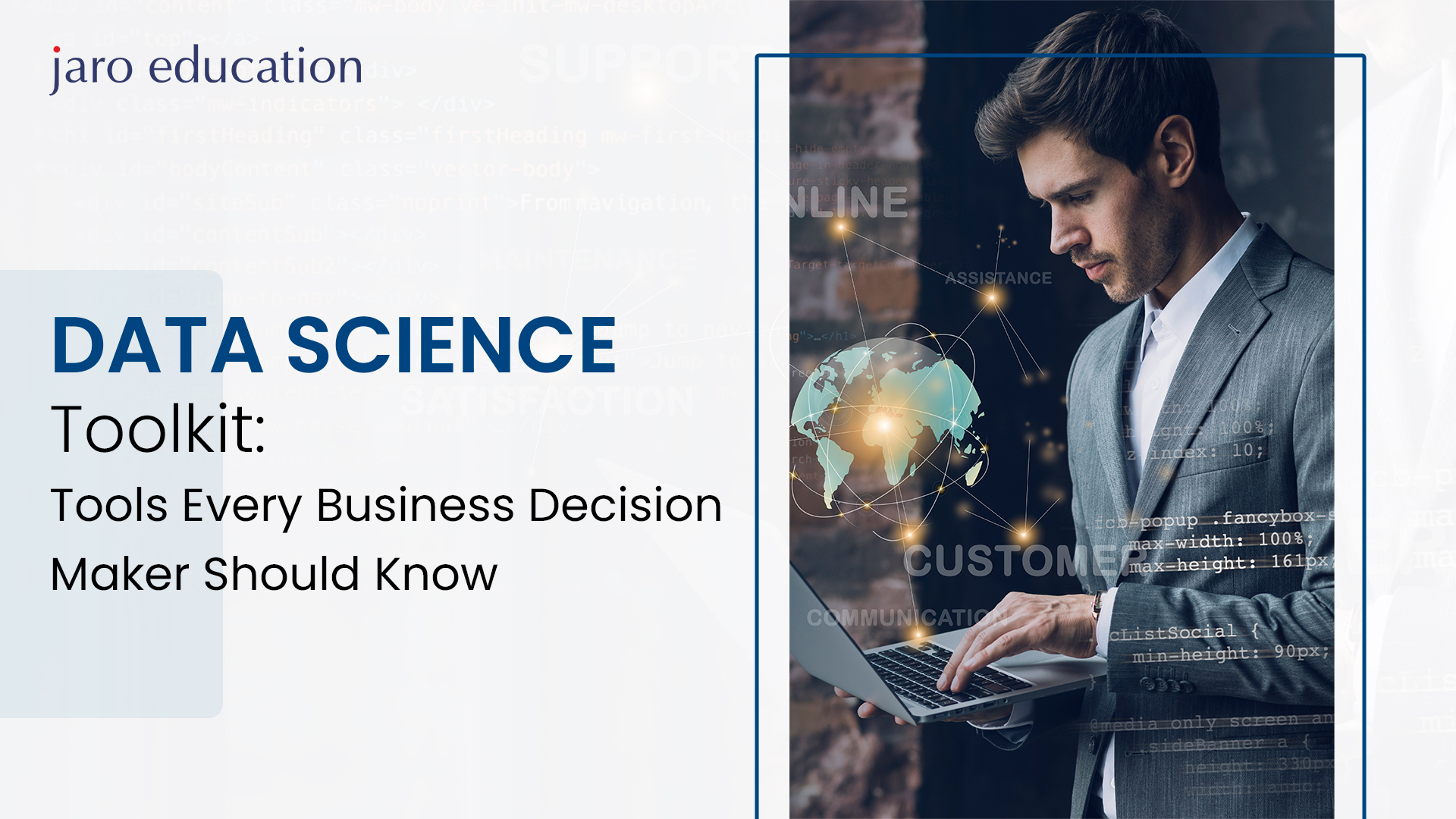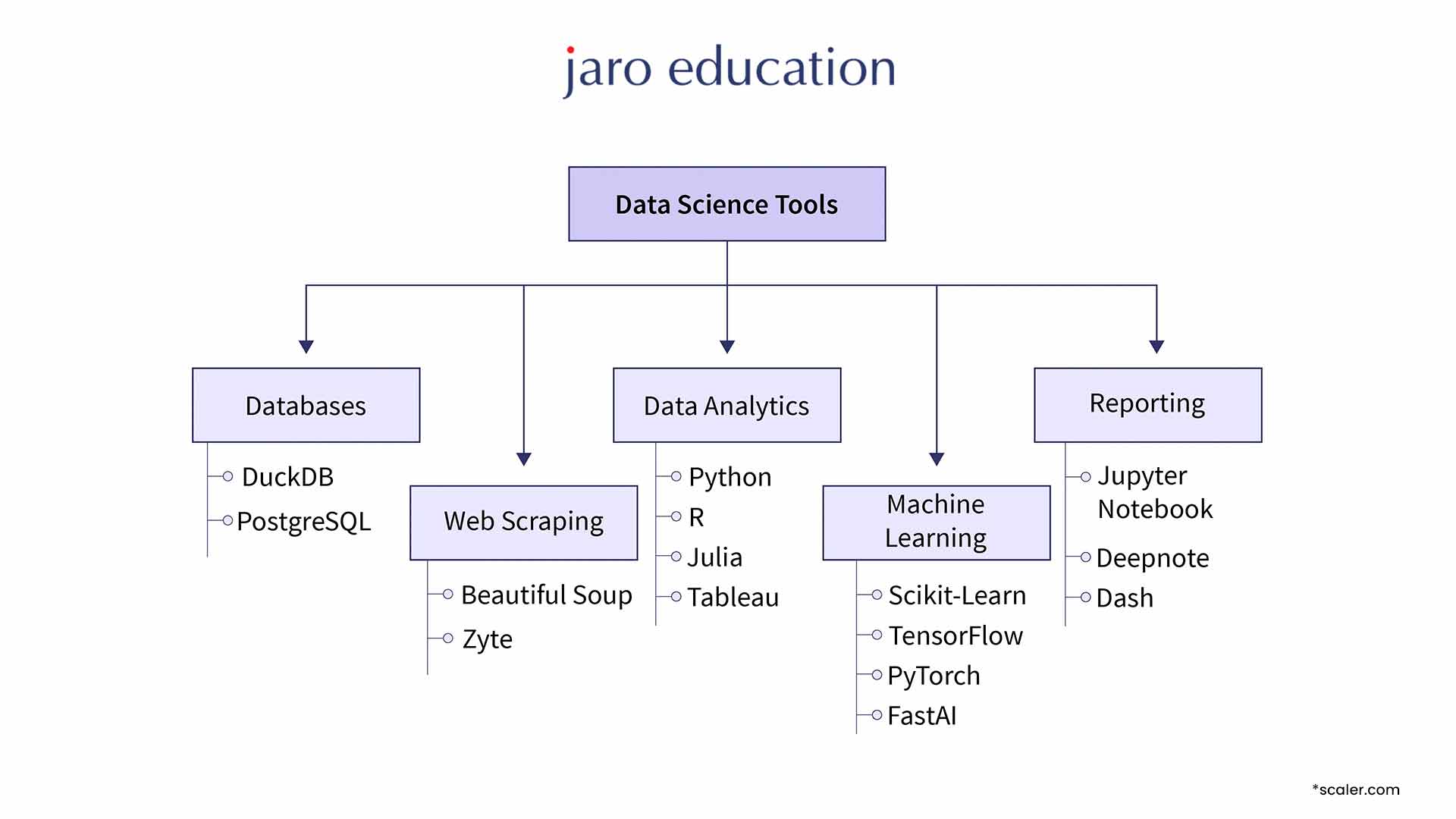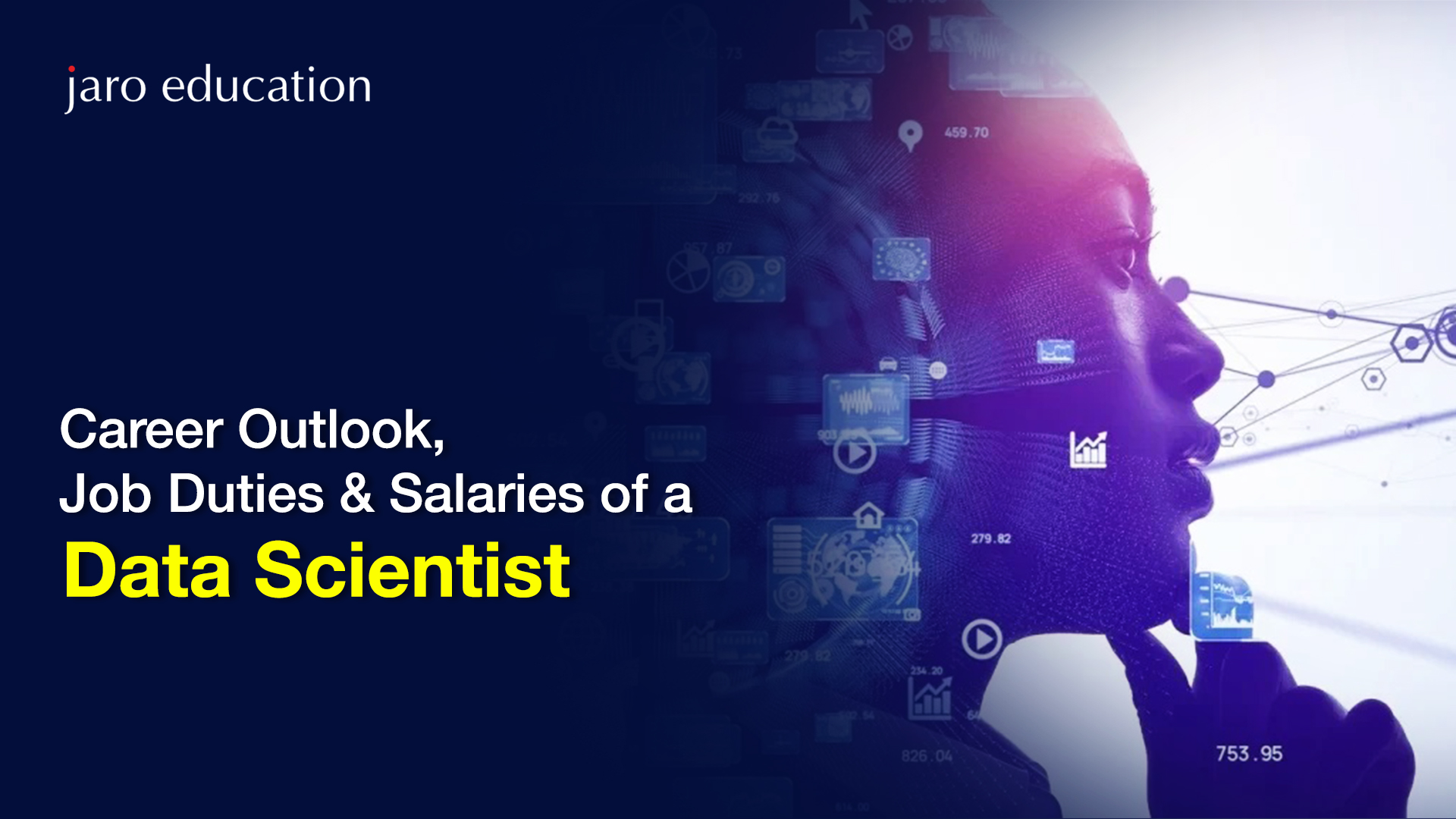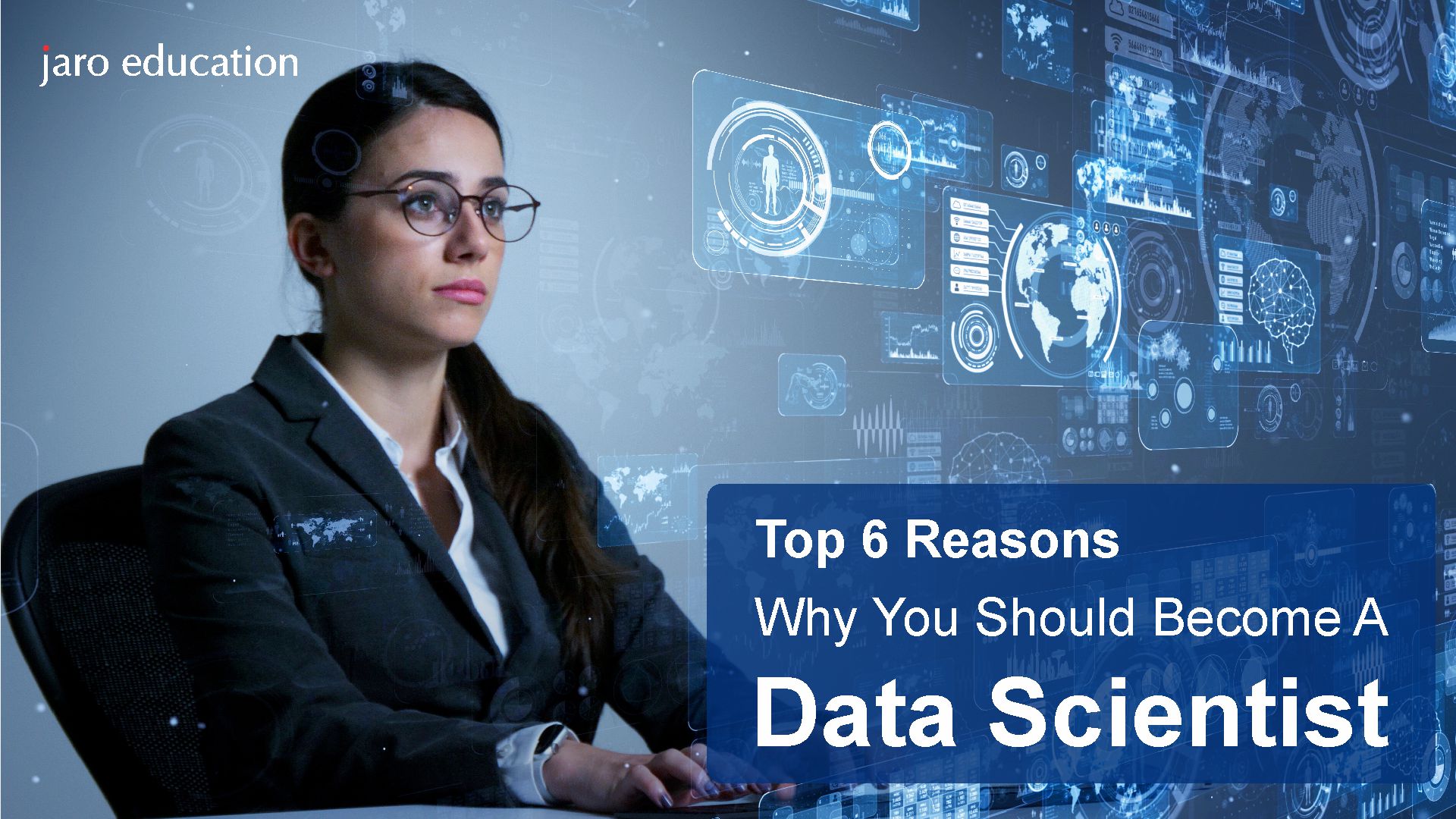The Data Science Toolkit: Tools Every Business Decision Maker Should Know
Table of Contents

- jaro education
- 30, October 2023
- 5:00 pm
Data science is the art of extracting and presenting actionable insights from data. Essentially, it involves the collection, analysis, and modelling of data to tackle real-world challenges. To perform these tasks and solve problems, data scientists rely on specialised tools that eliminate the need for extensive programming knowledge. These tools encompass algorithms, pre-defined functions, and user-friendly graphical interfaces (GUIs). Because data science demands swift execution, it is important to note that a single tool may not suffice; multiple tools are often necessary to excel in this field.
In this blog, we will explore the data science toolkit – a set of tools and platforms that play a crucial role in enabling data scientists to extract actionable insights from data. These tools are not just the domain of data scientists; they are essential for business decision-makers as well.
Data Science Tool Categories
The use of data science tools facilitates the many processes involved in a data science project, including data analysis, data collecting from databases and websites, the creation of machine learning models, the transmission of results via the creation of dashboards for reporting, etc.
These tools can be categorised into five groups as per the types of activities they are used for, as listed below:

- Database
- Web Scraping
- Data Analytics
- Machine Learning
- Reporting
Tools Used by Every Business Decision Maker
The common data science tools for simplifying decision making for every business are as follows:
1. Apache Spark
It is an open-source data analytics and processing engine designed to handle huge numbers of data efficiently. It has gained popularity for its ability to process data in near-real-time, making it suitable for various applications, including continuous intelligence, extract-transform-load (ETL) processes, and batch jobs.
Key Features
- High-speed data processing for large datasets.
- Support for streaming data processing.
- Includes extensive developer libraries and APIs, including machine learning.
- Compatible with various file systems and data stores.
Limitations
- Requires familiarity with programming languages like Scala, Python, or Java.
- It may require substantial hardware resources for optimal performance.
2. IBM SPSS
IBM SPSS is a comprehensive software suite for managing and analysing complex statistical data. It consists of SPSS Statistics for statistical analysis and data visualisation; and SPSS Modeler for data science and predictive analytics.
Key Features
- End-to-end analytics support, from data preparation to model deployment.
- Integration with R and Python for extensibility.
- User-friendly interface, suitable for business analysts.
Limitations
- Licensing costs can be significant for large organisations.
- May require some training for advanced analytics tasks.
3. Julia
It is an open-source programming language for numerical computing, machine learning, and data science applications. It aims to combine the ease of high-level dynamic languages with the performance of statically typed languages.
Key Features
- High-performance computing capabilities.
- No need to define data types explicitly.
- Supports multiple dispatches for faster execution.
Limitations
- Smaller user base compared to languages like Python and R.
- Limited availability of libraries and packages compared to more established languages.
4. Jupyter Notebook
Facilitating interactive collaboration among data scientists, engineers, researchers, and other users, the Juptyer Notebook is a popular tool among data scientists. It helps users to create, edit, and share documents containing code, explanations, and visualisations.
Key Features
- Uses Interactive code execution and documentation in a single environment.
- Support for multiple programming languages.
- It has shareable and version-controlled notebooks.
Limitations
- May require some technical proficiency to set up and use effectively.
- Collaboration features may need additional configuration.
5. Keras
Keras simplifies the use of the TensorFlow machine learning platform and is designed to accelerate the development of deep learning models.
Key Features
- High-level API for building neural networks with less coding.
- Integration with TensorFlow for scalability.
- Supports both CPU and GPU execution.
Limitations
- Limited to deep learning applications.
- It may not offer the same level of customisation as lower-level libraries.
6. Matlab
This is a programming language and analytics environment primarily used for numerical computing, mathematical modelling, and data visualisation. It is known for its extensive library of functions and toolboxes.
Key Features
- Versatile for various numerical and scientific tasks.
- Prebuilt applications and extensive toolboxes.
- User-friendly interface for data analysis.
Limitations
- Licensing costs can be high.
- It may not be as commonly used in data science as Python or R.
7. Matplotlib
Matplotlib is an open-source Python plotting library used for data visualisation. It provides tools for creating static, animated, and interactive data visualisations within Python scripts, Jupyter Notebooks, and more.
Key Features
- Wide range of visualisation options.
- Integration with Python data analysis libraries.
- Suitable for both simple and complex visualisations.
Limitations
- Generate a learning curve for advanced customisation.
- Can be verbose for complex visualisations.
8. NumPy (Numerical Python)
NumPy is an open-source Python library widely used in scientific computing, engineering, and data science. It offers support for multidimensional arrays and various mathematical and logical functions.
Key Features
- Multidimensional array objects for efficient data manipulation.
- Linear algebra, random number generation, and other mathematical functions.
- High performance and compatibility with other Python libraries.
Limitations
- May require familiarity with array programming concepts.
- Limited support for high-level data manipulation tasks.
9. Pandas
It is an open-source Python library for data analysis and manipulation. It introduces data structures like Series and DataFrame, making it easier to work with structured data.
Key Features
- Improves the functions for data transformation, aggregation, and manipulation.
- Works in perfect harmony with other Python libraries.
- simplifies the processing of data by offering tools that are easy to use for rearranging datasets and handling missing data.
Limitations
- Best suited for tabular data; less ideal for other data types.
- Performance limitations with extremely large datasets.
10. Python
Known for its versatility, Python is a widely used programming language popular for its simplicity and readability. It is extensively employed in data analysis, data visualisation, machine learning, and various other domains.
Key Features
- Easy-to-learn syntax and readability.
- Provides extensive libraries and frameworks for data science.
- Consists of a large range of applications that can be applied to web development, scientific computing, etc.
Limitations
- GIL (Global Interpreter Lock) can limit multi-core performance.
- Performance may be lower than statically typed languages for some tasks.
11. PyTorch
It is a machine learning framework for building and training deep learning models. It emphasises fast experimentation and seamless transition to production deployment.
Key Features
- Tensors for model inputs, outputs, and parameters.
- Support for GPU acceleration.
- Demonstrates a rapid pace of investigation and debugging.
Limitations
- Smaller community compared to TensorFlow.
- Cannot create a deep learning curve for users.
12. SAS
SAS is an integrated software suitable for statistical analysis, advanced analytics, business intelligence, and data management. It provides a range of tools for data integration, analysis, and visualisation.
Key Features
- Use a wide range of analytics and data management tools.
- Integrate many data sources seamlessly.
- Count on a well-established reputation in the analytics sector.
Limitations
- Licensing costs can be high.
- Generates a learning curve for some advanced analytics tasks.
13. Scikit-learn
Python’s Scikit-learn is a free machine-learning library. For both supervised and unsupervised machine learning applications, it provides a broad selection of methods and models.
Key Features
- Investigate a sizable collection of machine learning techniques.
- Make use of tools for model selection and assessment.
- Connect easily with other Python libraries.
Limitations
- Has limited support for deep learning and reinforcement learning.
- Focuses on well-established algorithms only.
14. TensorFlow
TensorFlow is a free and open-source software library for artificial intelligence and machine learning. Its primary areas of study are deep neural network training and inference but it can be also used for many other tasks as well.
Key Features
- Harness deep learning capabilities through neural networks.
- Ensure compatibility with CPUs, GPUs, and TPUs.
- Seamlessly integrate with the Keras high-level API.
Limitations
- Cannot generate a learning curve for users who are new to deep learning.
- Less suited for non-deep learning tasks.
Data Science Platforms
There are commercially licensed data science systems that offer integrated capabilities for machine learning, artificial intelligence, and advanced analytics in addition to these separate technologies. These systems frequently provide a variety of functions, such as analytics capabilities, automated machine learning (AutoML), and machine learning operations (MLOps). Several well-known data science systems are:
- Alteryx Analytics Automation Platform
- Azure Machine Learning
- Databricks Lakehouse Platform
- DataRobot AI Cloud
- Google Cloud Vertex AI
- IBM Watson Studio
- Qubole
- Saturn Cloud
Conclusion
Data scientists and other professionals in the field must work with a variety of tools, including those for programming, big data, data science libraries, machine learning, data visualisation, and data analysis. They are able to analyse and derive meaning from granular data with the use of all of these data science tools and frameworks. With the aid of the proper educational program, you can learn how to utilise these tools. Individuals interested in uplifting their skills in data science can enroll for IIM Kozhikode‘s Professional Certificate Programme in Data Science for Business Decisions. To provide accessibility to this valuable opportunity for aspiring data science professionals, Jaro Education offers the option to enrol in this course. One should consider this program for its high quality, relevance, and potential career benefits.








1 thought on “The Data Science Toolkit: Tools Every Business Decision Maker Should Know”
Thank you for the valuable information on the blog.I am not an expert in blog writing, but I am reading your content slightly, increasing my confidence in how to give the information properly. Your presentation was also good, and I understood the information easily.
For more information Please visit the 1stepGrow website or AI and data science course.